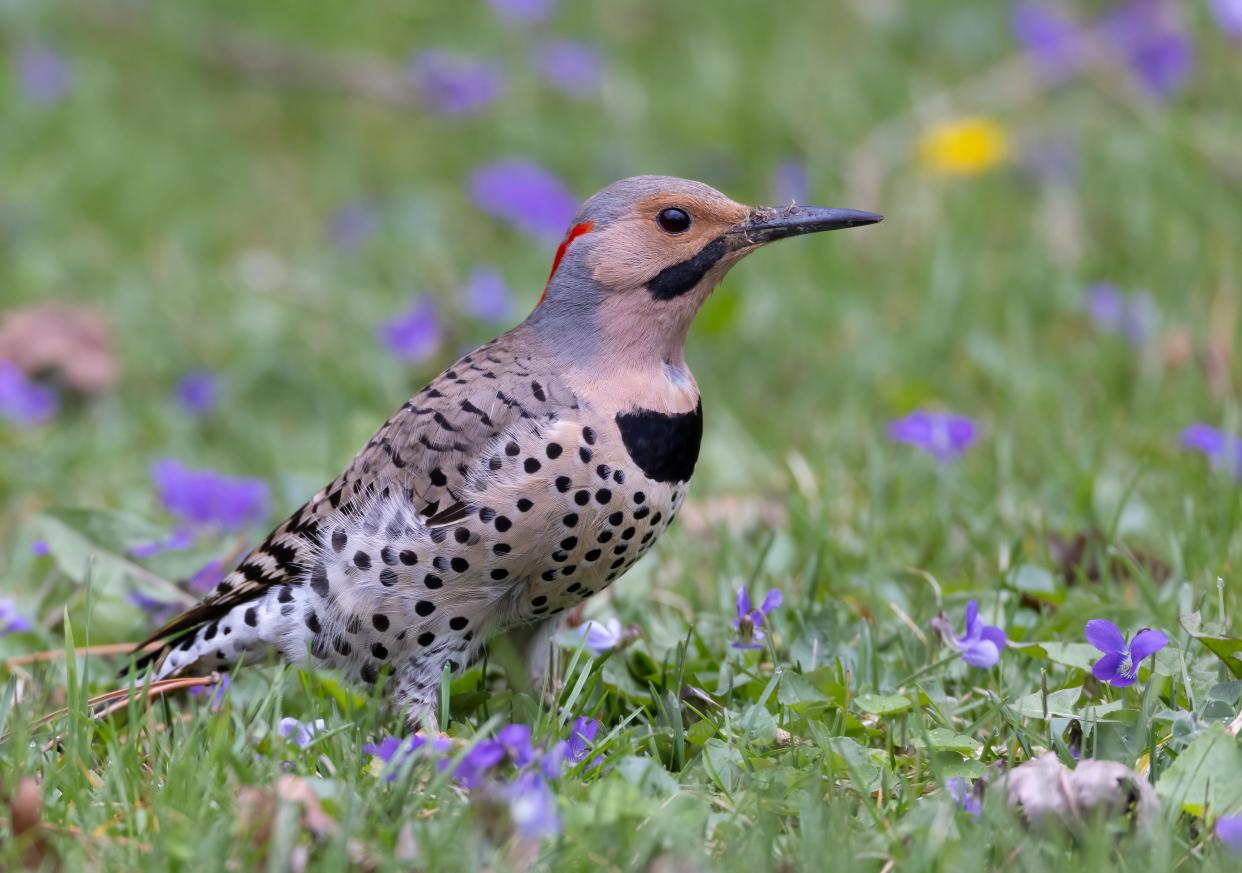Nature: Northern flickers are a sight to behold

Few birds have more common names than the northern flicker. This flashy woodpecker goes by cotton-rump, high-hole, yellowhammer and at least 150 other colloquialisms. All these monikers speak to the appearance, habitats, habits and appearance of the extroverted and charismatic woodpecker.
Of the seven woodpecker species that occur in Ohio, the flicker is one of the most common. Flickers are highly migratory. On a recent trip to Great Smoky Mountains National Park in Tennessee, I saw a spectacular example of flicker migration. While watching a big bruin black bear amble across a meadow, birds began to materialize and pour into a large lone maple in the field. Flickers!
About 75 of them. The maple looked like a Christmas tree adorned with woodpeckers. Closer to home, I glanced out my back window April 10 to see a male flicker foraging on the lawn. That’s right, on the ground – not high on tree bark like most woodpeckers. Flickers habitually hunt on the ground, as two of their main food sources, ants and beetles, are easiest to find there.
I quickly grabbed the big telephoto lens for shots, as a flicker is an incredible looker. The soft brown bird is barred like a zebra above, and stippled with round black dots below. When it lifts its wings, stunning golden-yellow underwings are exposed. A male, like the protagonist of this story, sports a black mustache. A bold black breast blotch and blaze of crimson on the nape complete the package.
It’s as if a committee of artists designed the bird, but didn’t bother to confer with one another. Yet the design came together beautifully. The flicker poked around for a good 15-20 minutes, rooting about and presumably lapping ants up with its long spiny tongue. It was especially smitten with parts of the yard that were awash with common blue violets (Viola sororia), a native species that can flourish in suburban lawns given half a chance.
Nature: An 8-legged fishing find that's a sight to see
I didn’t plant the violets, they’ve long been present and do quite well. But I don’t use chemicals orotherwise try to eradicate them as they’re welcome here. It’s probably no mystery why the “antbird” (one of the flicker’s colloquial names) cavorted in the violet patches. Violets are one of many groups of plants in which ants are the primary dispersers of seeds.
A violet seed has a fleshy appendage known as an elaiosome (e-ly-o-some) attached to one end. Theelaiosome is rich in amino acids, lipids and proteins – an excellent food source for ants. A harvesting ant grabs a violet seed, trundles off with it and at some point, probably well-removed from the source, nips off the elaiosome and leaves the hard inedible seed on the ground.
Elaiosome-seeking ants are a major way that violets get dispersed. It is estimated that nearly 5% of all the world’s plants have a relationship with ants. So important is this ant-seed dispersal relationship that it has its own name: myrmecochory (meer-meh-ko-kor-ee).

I suspect that my feral violet colonies have abetted the formation of ant colonies in their midst. Thus,two seemingly disparate organisms, a beautiful little spring wildflower and a large showy woodpecker, are directly connected. The violets have a direct role in feeding a cool woodpecker through their intimate relationship to seed-dispersing ants.
Some people probably would question the wisdom of allowing ant colonies to form in one’s backyard. Keep in mind that ants are an enormous group of insects, with over 12,000 species currently known worldwide. There are probably 150 species in Ohio. The overwhelming majority of ants are out of sight and mind, plying their trades independent of us. They do not invade homes or otherwise engage with people.
Nature: Once-abundant rusty blackbird threatened by habitat destruction
In fact, most people will never notice most of them. If ants can help brighten the largely sterile sod wastelands of suburbia with showy purple violets, spring beauties and other native wildflowers, more power to them. And flashy flickers are just icing on the cake.
Naturalist Jim McCormac writes a column for The Dispatch on the first and third Sundays of the month. He also writes about nature at jim mccormac.blogspot.com.
This article originally appeared on The Columbus Dispatch: Nature: Northern flickers bring beauty and ants bring benefits to Ohio

